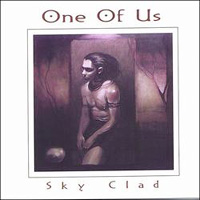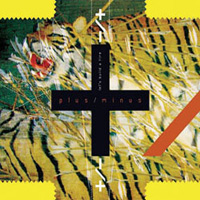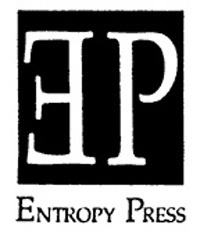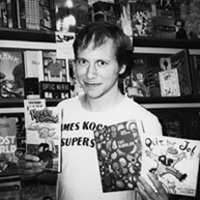 James Kochalka
James Kochalka
An interview with James Kochalka
by Chad Parenteau
At his recent appearance at Million Year Picnic, I asked Vermont-based cartoonist James Kochalka: Do you believe in fairies? “You know, it doesn’t seem likely,” he said. “I would really like to believe in fairies, but it seems highly unlikely.”
This would have been a preposterous question to ask anyone else, but Kochalka draws fairies – as well as self-aware robots, elves and talking cats – on a regular basis. As a child, he made a conscious decision to never stop believing in fairies. Despite his answer to my question, it’s clear that this outlook has carried over to his adulthood. Kochalka has produced an enormous and sometimes controversial body of work in just a few short years.
In addition to this accomplishment, Kochalka has recently achieved something else he was proud to speak of. To my surprise, it wasn’t Tiny Bubbles, his new 192 page graphic novel from the Picnic’s Highwater Books. That, says Kochalka, was finished a year ago, although it took a while for Picnic/Highwater’s Tom Devlin to publish it. His recent accomplishment had nothing to do with his work; it involved an IQ test which his wife Amy, a special education teacher in Swanton, Vermont, had given him.
“My IQ is 133,” he announced during the interview, “which doesn’t sound like a real high number, but the average is 85 to 115; above-average is 115-130; superior is the range that I’m in, and then… you have genius. I hate to disappoint everyone who claims I’m a genius, but I’m not a genius. I’m in the ninety-ninth percentile. Only one percent of human beings are smarter than me… But if you think about that, that means there’re 50 million people in the world who are smarter than me, and that’s a lot of people. That’s kind of disappointing.” He laughs. “I’m sure there will be plenty of people who are smarter than me who will be reading the interview saying, ‘Pfft. That’s not so smart!'”
We do eventually get to talk about Tiny Bubbles, not only what it’s about, but also what it could have been about.
“It’s about the breakdown of the human body and the face of advancing technology. But it’s about a lot of fun and cute stuff, too. It’s about me and my wife, and we go to a big party, and we smoke cigarettes and fly off the building, and fly around a little bit, and I get a haircut, and there’s a robot in it… He stalks me.”
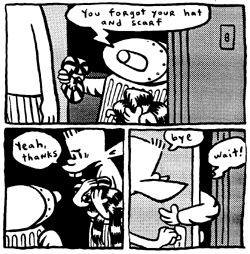 But the plot Kochalka had originally intended for Tiny Bubbles was quite different: “[The characters] were going to drive out in a lunar buggy to a big crater in the moon, where they were going to find a crashed alien spaceship and a bunch of alien comics; then I was gonna draw the alien comics. But that never happened. They were also going to find alien cigarettes, but that never happened either.” The story is set on the moon, which just happens to look like Earth – a planet with snow, bodies of water, and apartments. The settings, characters and roles of Kochalka’s characters often change with every new story.
But the plot Kochalka had originally intended for Tiny Bubbles was quite different: “[The characters] were going to drive out in a lunar buggy to a big crater in the moon, where they were going to find a crashed alien spaceship and a bunch of alien comics; then I was gonna draw the alien comics. But that never happened. They were also going to find alien cigarettes, but that never happened either.” The story is set on the moon, which just happens to look like Earth – a planet with snow, bodies of water, and apartments. The settings, characters and roles of Kochalka’s characters often change with every new story.
Tiny Bubbles, at 192 pages, took him only six months to complete. And at the same time he was working on smaller pieces (which, sadly enough, end up earning him more money than the long works). What’s more, he expected it to be even longer.
“I much prefer just drawing and not worrying about the page count,” he said. “I’d rather make the story be whatever number of pages is necessary to tell the story and not have to worry about that a comic book has to be x-number of pages, or else.”
After self-publishing the first issue of his mini-comic, James Kochalka Superstar (which still comes out occasionally), it took him only two years to be commercially published. In fact, since 1996, his work has been under the banners of five different companies (Alternative, Black Eye, Highwater, Slave Labor, and Top Shelf). This jumping around, Kochalka said, is because “no one publisher can handle my huge output. It’s not like the books are making a big profit, and it’s too much work for any one publisher to handle.”
Despite the fact that the world of mini-comics is thriving – a sizable pile of them was placed on Kochalka’s signing table as gifts from local artists – that wasn’t why he started his own. “I just started drawing comics in third grade, and I never stopped really, except for a few years during college when I was painting instead. But for the most part, I’ve always drawn comics. In high school, I had an anthology called Anarchy Today, and I would draw strips for that. I’d make all my friends draw comics for it too, even my friends who weren’t really comics people.”
Although he had his share of superhero comics, his favorites growing up were Casper and Richie Rich. “I liked the Marvel comics too, but they were kind of scary and creepy. They had scary monsters in them. The Hulk, he’s a scary monster. Sub Mariner, he has weird, murky underwater scenes. Even Tin Tin scared me. On an island, he found a big pile of human skulls. Ugh! After that, I couldn’t read Tin Tin for a while.”
He also lists such classic strips as Krazy Kat and Little Nemo in Slumberland. “I like Krazy Kat, and Casper the Friendly Ghost. I still have them in boxes at my parents house,” he says. “But my cat peed all over my Casper and Richie Rich comics when I was a kid anyhow, so they’re kind of funky.”
Kochalka also lists Schultz as an influence. “That pretty much goes without saying.” One of his more recent works, Paradise Sucks, was based on Schultz and how “his lines just kept getting shakier and shakier and shakier.”
“What I would like is if someone would publish a giant encyclopedia of every single comic he’s ever done, but he would never allow that. He’s embarrassed by many of them.”
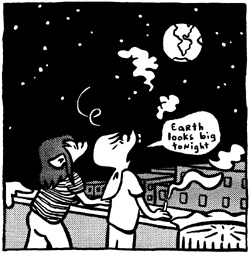 As I mentioned, there is some controversy surrounding Kochalka’s work. Critics complain that either it’s too simplistic or too pretentious. To stand with or against him is to choose a spot in a trench war, as can be seen in the monthly magazine The Comics Journal, where debate and general outrage from readers to fellow cartoonists still goes on concerning a letter Kochalka wrote two years ago (published in issue #189), with the following declaration: “I just felt suddenly like I had to write and say that craft is the enemy! You could labor your whole life perfecting your craft, struggling to draw better, hoping one day to have the skills to produce a truly great comic. If this is how you’re thinking, you will never produce this great comic.”
As I mentioned, there is some controversy surrounding Kochalka’s work. Critics complain that either it’s too simplistic or too pretentious. To stand with or against him is to choose a spot in a trench war, as can be seen in the monthly magazine The Comics Journal, where debate and general outrage from readers to fellow cartoonists still goes on concerning a letter Kochalka wrote two years ago (published in issue #189), with the following declaration: “I just felt suddenly like I had to write and say that craft is the enemy! You could labor your whole life perfecting your craft, struggling to draw better, hoping one day to have the skills to produce a truly great comic. If this is how you’re thinking, you will never produce this great comic.”
“I was just trying to let the kids know that they don’t have to wait until they’ve somehow perfected their comics before they start.
“People are afraid to start drawing because they’re afraid they’re not going to do a good job, so they end up never doing anything. All of my comics in Magic Boy and Girlfriend [a collection of his mini-comics from Top Shelf] were all drawn before I was any good, and here I am with a big book all published and everything, fancy and nice.”
Then of course, there’s the question most asked of him: What about the name “Superstar“?
“Well, it certainly makes me seem much more special, doesn’t it?” he says, laughing. He cites his childhood, once again, as the root of that. “In kindergarten, they try and tell every kid that they’re special in their own special way, and it’s not true. I grew up thinking I was special and assuming that the world would be handed to me on a silver platter… Now I’m just waiting for my due.”

